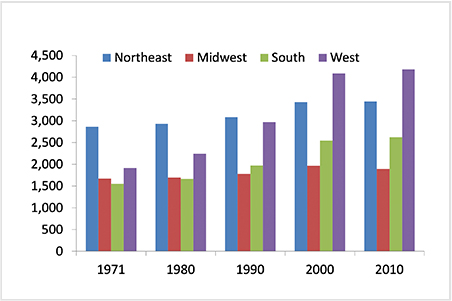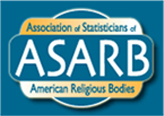General Users
-
The sponsoring group, ASARB, plans to produce a 2030 edition in conjunction with the U.S. Census.
-
Reports and maps detailing religious adherence at the county level (or metro, state, and national levels) are available at this site as well as at The Association of Religious Data Archives.
-
Chances are they have, but you can see a listing of the groups that have participated in previous studies here: (History of Participation)
-
We hope so, but independent churches are not listed separately. They are aggregated at the county level with other independent churches.
-
Our counts are based on the people associated with specific congregations in each county or county equivalent. This is different from asking people what religion they identify with. Self-identification is certainly a valid sociological indicator. However, participation has also been shown to be an important indicator, and our count focuses on that dimension.
Participating Religious Groups
-
Your religious body benefits in several ways. U.S. Religion Census provides each participating group with a set of maps showing their data. These are especially beneficial for those groups that have participated before because they will be able to see the change that has taken place over time. The study also provides each participating religious body with a copy of any printed or electronic material produced by the U.S. Religion Census. Because you are providing the data included in the study, your religious body will be accurately represented when local or national media report on religious geography and adherents. Your group will also be included when sociologists of religion undertake research and writing. And when individuals go online looking for the religious make-up of a community, your religious body will be included.
-
Chances are they have, but you can see a listing of the groups that have participated in previous studies here: (History of Participation)
-
Religious bodies are asked to provide the following data aggregated to the county level: the number of congregations, the number of members (if available), the number of attendees (if available), and the number of adherents (if available).
-
The minimum information necessary to participate in the data collection is the number of congregations by county.
-
U.S. Religion Census can help you with that. Just send us a list of your congregations with their physical addresses (and include any available membership, attendee, and adherent data). We will determine their county locations and aggregate the data for you. (Note: Any address information provided to U.S. Religion Census will only be used to determine county locations of congregations. Address information will never be sold or distributed. It will be destroyed once you sign off on the aggregated figures.)
-
Congregations may be churches, mosques, temples, or other meeting places. A congregation is generally defined as a group of people who meet regularly (typically weekly or monthly) at a pre-announced time and location.
-
Members are determined by the by-laws of each participating group. Members in Christian Protestant denominations are most often referred to as "full" or "communicant members."
-
The adherent figure is meant to be the most complete count of people affiliated with a congregation, and the most comparable count of people across all participating groups. Adherents may include all those with an affiliation to a congregation (including children, members, and other regular attendees who are not members). If a participating group does not provide the number of adherents, the U.S. Religion Census may estimate the number of adherents through the use of a statistical procedure (this will only be done with the approval of the participating group). For groups that report the number of members but not adherents, the general formula for estimating adherents is: Compute what percentage the group's membership is of the county's adult population (14 and older), and then apply that percentage to the county's child population (13 and younger), and then take the resulting figure and add it to the group's membership figure.
-
The U.S. Religion Census is looking for the number most comparable to an average attendance (weekly or monthly, depending on the frequency of the group's meetings) at worship services.
-
Absolutely not.
Consultants, Vendors, Developers
-
ASARB (the U.S. Religion Census copyright holder and study sponsor) wants you to use the data and products, but we do not want you to distribute the dataset or products without proper permission. If you have any question about obtaining proper permission, please contact us.
-
You can download the dataset for free from this site as well as from the Association of Religion Data Archives. This includes permission to use the data for studies or reports or analyses, but does not grant permission to redistribute or repost the data.
Researchers / Writers
-
You can download the dataset for free from this site as well as from the Association of Religion Data Archives. This includes permission to use the data for studies or reports or analyses, but does not grant permission to redistribute or repost the data.
-
Citations to the current study should contain all the following information in this or other form:
Clifford Grammich, Erica Dollhopf, Mary Gautier, Richard Houseal, Dale E. Jones, Alexei Krindatch, Richie Stanley, and Scott Thumma. 2023. 2020 U.S. Religion Census: Religious Congregations & Membership Study. Association of Statisticians of American Religious Bodies.Citations for the previous studies:
Clifford Grammich, Kirk Hadaway, Richard Houseal, Dale E. Jones, Alexei Krindatch, Richie Stanley, and Richard H. Taylor. 2012. 2010 U.S. Religion Census: Religious Congregations & Membership Study. Association of Statisticians of American Religious Bodies.
Jones, Dale E., Sherri Doty, Clifford Grammich, James E. Horsch, Richard Houseal, Mac Lynn, John P. Marcum, Kenneth M. Sanchagrin and Richard H. Taylor. 2002. Religious Congregations and Membership in the United States 2000: An Enumeration by Region, State and County Based on Data Reported by 149 Religious Bodies. Nashville, TN: Glenmary Research Center.
-
Contact ASARB






